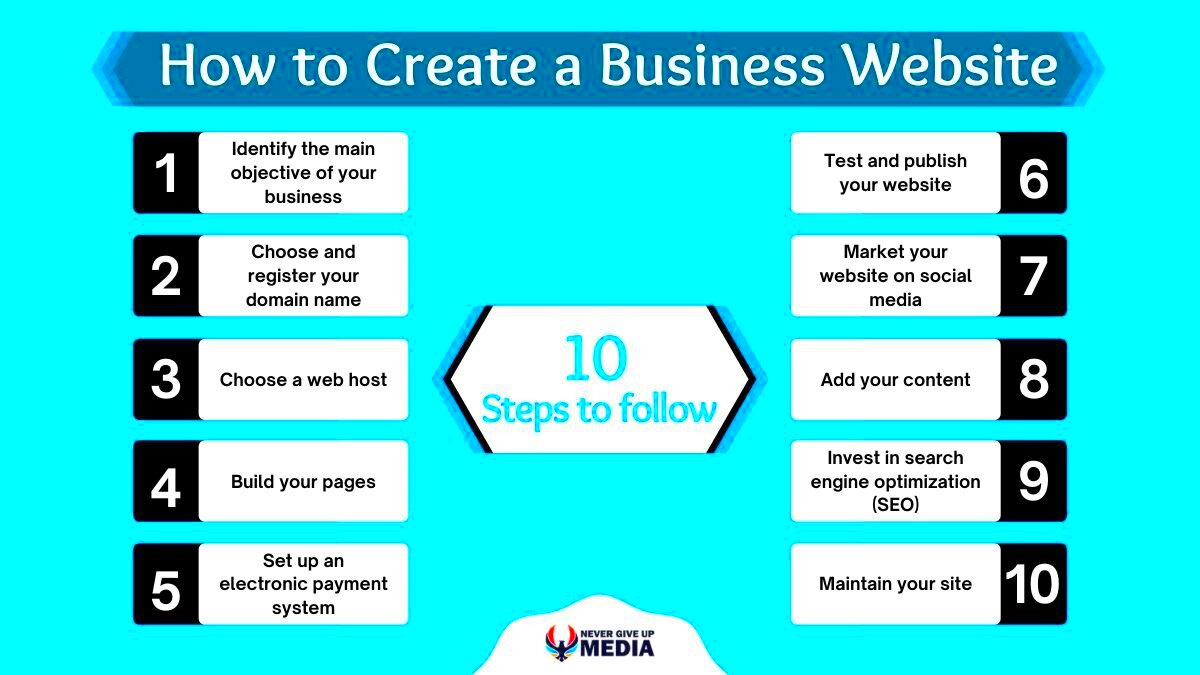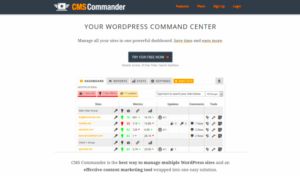Creating a business website can seem like a daunting task, but it doesn’t have to be! Whether you’re a small business owner, a freelancer, or just looking to establish an online presence, building a website is a vital step in today’s digital world. Your website acts as your business’s virtual storefront, where potential customers can learn about your products or services, get in touch, and even make purchases. In this guide, we’ll break down the process into manageable steps, making it accessible for everyone, regardless of their technical skills.
Step 1: Define Your Website’s Purpose and Goals

Before you dive into the nitty-gritty of designing your website, it’s crucial to clearly define its purpose and set specific goals. This foundational step will guide your decisions throughout the website creation process. Here are some important considerations to keep in mind:
- Identify your audience: Who are you trying to reach? Understanding your target demographic is essential for tailoring your content and design to meet their needs.
- Clarify your offerings: What products or services will you feature? Be clear about what you want to present to visitors.
- Set specific goals: What do you want to achieve with your website? Consider goals like increasing sales, building brand awareness, or generating leads. Here’s a simple table of potential goals:
| Goal Type | Description |
|---|---|
| Sales | Directly sell products or services online. |
| Information | Provide details about your business, services, and FAQs. |
| Lead Generation | Collect contact information for future marketing efforts. |
By answering these questions and documenting your goals, you’ll create a roadmap for your website that will help keep you focused and aligned as you start the building process. It’s like plotting out a course on a map before you head out on an adventure!
Step 2: Choose a Domain Name

Choosing a domain name is a critical step in creating your business website. It’s like naming your baby—make it memorable, relevant, and uniquely yours! A well-thought-out domain name not only reflects your business identity but also significantly impacts your online presence.
Here are some tips to help you pick the perfect domain name:
- Keep it Short and Simple: Aim for a name that’s easy to spell, pronounce, and remember. Longer names increase the chance of typos and misunderstandings.
- Incorporate Keywords: If possible, include keywords that relate to your business. This helps with SEO (Search Engine Optimization) and makes it easier for users to identify what you offer.
- Use a Relevant Domain Extension: The most common extension is .com, but don’t shy away from others like .net, .org, or niche-specific extensions like .store or .tech. Choose one that fits your business type.
- Avoid Special Characters: Hyphens and numbers can confuse potential visitors. Stick to letters to keep it straightforward.
- Check Availability: Once you have a few options in mind, use a domain registration service to see if they’re available. If your chosen name is taken, think of variations.
Finally, purchasing your domain should be straightforward. Choose a reputable registrar, and once you’ve done that, you’re one step closer to launching your online presence!
Step 3: Select a Web Hosting Provider
Once you have your domain name locked down, the next step is selecting a web hosting provider. Your web host is like the foundation of your website—without a solid one, your site may collapse under the pressures of high traffic or technical issues.
Here are some key considerations when choosing a web hosting provider:
- Understand Different Hosting Types: Familiarize yourself with options like shared hosting, VPS (Virtual Private Server), dedicated hosting, and cloud hosting. Each comes with its pros and cons, so choose based on your needs.
- Reliability and Uptime: Look for a host that offers at least 99.9% uptime. Downtime can lead to lost visitors and revenue, so choosing a reliable provider is essential.
- Speed: Research the host’s server speed. A fast-loading website enhances user experience and helps with SEO rankings.
- Customer Support: Opt for a hosting provider with 24/7 customer support to assist you in case of any emergencies. Live chat and phone support are usually the most effective.
- Pricing: Compare hosting plans. Make sure to check what’s included in the price, like domain registration, SSL certificates, and backups. Look for a balance between cost and quality.
Selecting the right web host sets the stage for a successful website. Take your time to research and find a provider that checks all the boxes—you won’t regret it!
Step 4: Plan Your Website Structure
When it comes to building a business website, having a well-thought-out structure is crucial. Your website’s structure is like the blueprint of a house—it determines how everything fits together. A clear and logical structure makes it easy for both visitors and search engines to navigate your site effortlessly.
Let’s break down the steps to planning your website structure:
- Identify Your Goals: What do you want your website to achieve? Whether it’s generating leads, offering services, or selling products, knowing your goals will inform how you layout your website.
- Determine Core Pages: Most business websites include essential pages such as:
- Home
- About Us
- Services/Products
- Blog/Resources
- Contact
- Create a Sitemap: A sitemap outlines your website’s primary and sub-pages. This is a simple visual representation that helps you understand how everything connects.
- Consider User Experience: Always think of your visitors. Organize your content logically to guide them effortlessly from one section to another.
- Optimize for SEO: Search engines love well-structured websites. Use descriptive URLs and keep your categories clear for better indexing.
Remember, planning your website structure is a foundational step. Take the time to get it right, and it will pay off in the long run!
Step 5: Design Your Website
Now that you have your website structure laid out, it’s time to bring it to life with design! The way your website looks and feels plays a pivotal role in attracting and retaining visitors. A well-designed website is visually appealing, easy to navigate, and aligns with your brand identity.
Here’s how to approach the design of your website:
- Choose a Color Scheme: Select colors that reflect your brand personality. Stick to a palette of 3-5 colors for consistency.
- Select Fonts Wisely: Choose legible fonts that match your brand voice. Use different font sizes for headings, subheadings, and body text to create a clear hierarchy.
- Incorporate Your Brand Elements: Use your logo, imagery, and accent colors to reinforce your brand. Every element should tie back to your overall branding.
- Prioritize Visuals: Invest in high-quality images or graphics. Visual content captures attention and can convey messages more powerfully than words alone.
- Responsive Design: Ensure your website is mobile-friendly! With more people browsing on their phones, your site should adjust perfectly to any screen size.
Don’t forget that design is an ongoing process. Test different layouts, gather feedback, and be prepared to make tweaks based on user interactions. After all, a well-designed website not only looks great but also helps users connect with your brand and encourages them to take action!
Step 6: Create High-Quality Content
Now that you’ve set up your website and established its structure, it’s time to focus on one of the most critical aspects of your online presence: high-quality content. Your content is what will engage visitors, keep them on your site, and, ultimately, convert them into customers.
Here are some tips for creating content that captivates your audience:
- Know Your Audience: Start by understanding who your ideal customer is. What are their interests? What challenges do they face that your business can solve? Tailoring your content to meet their needs will resonate more.
- Value-Driven Approaches: Ensure your content provides value. Whether it’s blog posts, videos, or infographics, aim to inform, entertain, or inspire your audience.
- Engaging Writing Style: Write in a friendly and conversational tone. Avoid jargon; instead, use simple, relatable language. It helps build a connection with your readers.
- Incorporate Visuals: Break up large blocks of text with images, graphs, or videos. Visual content can significantly enhance understanding and retention.
Additionally, here’s a quick checklist for creating high-quality content:
| Checklist Items |
|---|
| Does it answer a question your audience has? |
| Is it informative and accurate? |
| Is it engaging and easy to read? |
| Have you included relevant keywords? |
| Are there call-to-action prompts? |
Remember, your content is your voice online. Make it count!
Step 7: Optimize for Search Engines (SEO)
Once your content is polished and ready to go, the next step is optimization—specifically, Search Engine Optimization (SEO). SEO is like the GPS for your website; it helps search engines understand what your content is about and ensures your site appears in search results when users look for relevant information.
Here are essential elements to focus on for better SEO:
- Keyword Research: Start with thorough keyword research. Use tools like Google Keyword Planner or Ubersuggest to find keywords relevant to your business and integrate them naturally throughout your content.
- Meta Tags: Ensure each page has unique title and meta description tags. These tags summarize your content for search engines and users, helping to improve click-through rates.
- Mobile Optimization: With more people browsing on mobile devices, ensure your site is mobile-friendly. Google prioritizes mobile-optimized sites in search rankings.
- Internal and External Links: Use links strategically. Internal links can guide visitors to other relevant content on your site, while external links to reputable sources can enhance credibility.
Lastly, it’s essential to monitor your SEO performance. Consider using tools like Google Analytics to track how your audience is finding you and what content resonates best. Here’s a brief table with key SEO metrics to keep an eye on:
| SEO Metrics |
|---|
| Organic Traffic |
| Bounce Rate |
| Averaged Time on Page |
| Keyword Rankings |
| Backlink Profile |
By ensuring your site is optimized, you enhance your visibility, allowing potential customers to discover you more easily. Happy optimizing!
Step 8: Test Your Website
Testing your website is like a final dress rehearsal before the big show. You want to ensure everything works perfectly, and your visitors have a seamless experience. So, how do you go about testing your website? Here’s a handy checklist to get you started:
- Check Links: Make sure all your links lead to the right pages. Broken links can frustrate visitors and negatively impact your SEO.
- Test Forms: If you have contact forms, sign-ups, or shopping carts, test them thoroughly. Fill them out and ensure submissions are received correctly.
- Review Content: Read through your content for typos, grammatical errors, and clarity. Remember, first impressions matter!
- Evaluate Load Speed: Use tools like Google PageSpeed Insights to check how quickly your website loads. Slow sites can drive visitors away.
- Mobile Responsiveness: With more users browsing on mobile devices, check how your site looks on different screen sizes.
- Cross-Browser Testing: Ensure your website functions properly across all major browsers (Chrome, Firefox, Safari, Edge).
- SEO Check: Use SEO tools to analyze on-page elements like title tags, meta descriptions, and image alt text.
And don’t forget about user testing. Invite a few friends or colleagues to navigate your site and provide feedback. Fresh eyes can spot issues you might overlook!
Step 9: Launch Your Website
Congratulations! You’ve put in the hard work. It’s time to launch your website and let the world see what you’ve created. But before you hit that “Publish” button, let’s go through a few final steps to ensure a successful launch:
- Choose the Right Time: Pick a launch time when your target audience is most active. This increases the chances of immediate traffic and visibility.
- Double-Check Everything: Go through your checklist one last time. Check your URLs, content, and all functionalities once more.
- Create a Launch Plan: Consider doing a soft launch first, perhaps through a private beta. Plan for a full-scale launch with marketing announcements.
- Promote Your Launch: Utilize social media, email newsletters, and possibly paid ads to announce your newly launched site.
- Monitor Traffic: Use tools like Google Analytics immediately after launch to track visitor activity. It helps you understand how users are interacting with your site.
Launched websites can stir up excitement, so don’t hesitate to celebrate your hard work! Share it with friends, colleagues, and on social media to spread the word. Remember, launching your website is just the beginning of your ongoing journey to reach, engage, and grow your audience.
Step 10: Promote and Maintain Your Website
Once your business website is up and running, the fun doesn’t stop there! Promoting and maintaining your website is just as crucial as the initial creation process. Think of your website as a garden; it needs regular care and attention to thrive.
First off, let’s talk promotion. Getting your website out there is essential. Here are some effective strategies:
- Social Media Marketing: Use platforms like Facebook, Instagram, and Twitter to share your website. Create engaging posts that link back to your site.
- Email Marketing: Build an email list and send newsletters that include links to your latest blog posts or updates on your products/services.
- Search Engine Optimization (SEO): Optimize your website’s content so that it ranks higher on search engines like Google. This includes using the right keywords and creating quality content.
- Pay-Per-Click Advertising: Consider using Google Ads or social media ads to direct traffic to your site. It can give you a quick boost in visibility.
Now, maintaining your website is equally important. Regular maintenance ensures that your site runs smoothly and remains relevant. Here are some maintenance tasks you should keep in mind:
| Task | Frequency |
|---|---|
| Update Content | Monthly |
| Check for Broken Links | Quarterly |
| Backup Your Website | Weekly |
| Update Plugins and Themes | Monthly |
| Analyze Website Traffic | Monthly |
By promoting and consistently maintaining your website, you’re setting yourself up for long-term success. You’ll foster a loyal audience that keeps coming back!
Conclusion
Creating a business website may seem like a daunting task, but with the right steps, it can be an exciting and rewarding journey. From defining your goals to promoting and maintaining your site, each step plays an integral role in establishing your online presence.
Remember, your website is the digital face of your business. It’s not just about aesthetics; it’s about functionality, user experience, and providing real value to your audience. Let’s recap the key points that will lead to a successful website:
- Define Your Purpose: Know what you want to achieve and who your target audience is.
- Choose the Right Platform: Select a website builder or CMS that aligns with your goals.
- Design with Users in Mind: Create a user-friendly layout that is visually appealing and easy to navigate.
- Develop Quality Content: Produce engaging content that resonates with your audience and drives traffic.
- Promote and Maintain Your Site: Use various marketing strategies to keep your website in the public eye.
Creating a business website is an ongoing process; it evolves as your business grows. So, don’t hesitate to experiment and adapt strategies based on feedback and analytics. In no time, you’ll have a vibrant online presence that attracts and retains customers. Happy website building!



